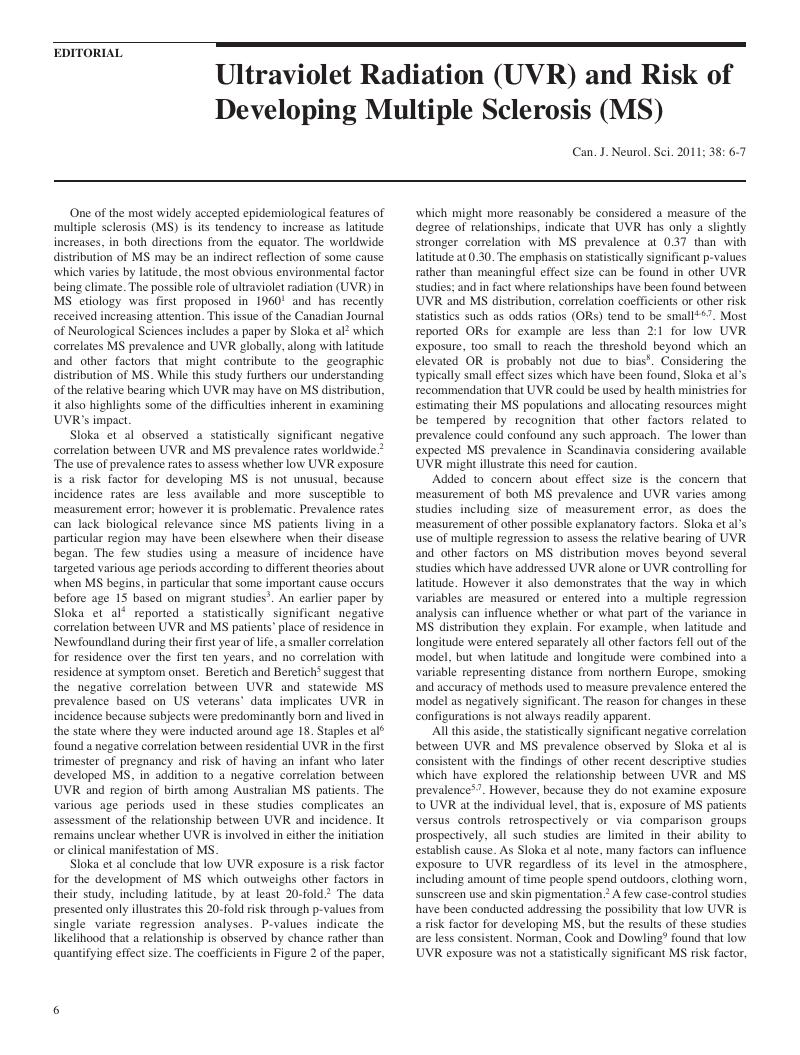No CrossRef data available.
Article contents
Ultraviolet Radiation (UVR) and Risk of Developing Multiple Sclerosis (MS)
Published online by Cambridge University Press: 02 December 2014
Abstract
An abstract is not available for this content so a preview has been provided. As you have access to this content, a full PDF is available via the ‘Save PDF’ action button.

- Type
- Editorial
- Information
- Copyright
- Copyright © Canadian Neurological Sciences Federation 2011
References
1
Acheson, ED, Bachrach, CA, Wright, FM.
Some comments on the relationship of the distribution of multiple sclerosis to latitude, solar radiation and other variables. Acta Psychiatr Scand. 1960; 35
Suppl 147:132–47.Google Scholar
2
Sloka, S, Silva, C, Pryse-Phillips, W, Patten, S, Metz, L, Wee Yong, V.
A quantitative analysis of suspected environmental causes of MS. Can J Neurol Sci. 2011;38(1):98–105.Google Scholar
3
Wolfson, C, Wolfson, DB, Zielinski, JM.
On the estimation of the latent period of multiple sclerosis. Neuroepidemiology. 1989;8: 239–48.Google Scholar
4
Sloka, JS, Pryse-Phillips, WEM, Stefanelli, M.
The geospatial relationship between ultraviolet radiation and multiple sclerosis in Newfoundland. Can J Neurol Sci. 2008;35(1):69–74.Google Scholar
5
Beretich, BD, Beretich, TM.
Explaining multiple sclerosis by ultraviolet exposure: a geospatial analysis. Multiple Sclerosis. 2009;15:891–8.Google Scholar
6
Staples, J, Ponsonby, A-L, Lim, L.
Low maternal exposure to ultraviolet radiation in pregnancy, month of birth, and risk of multiple sclerosis in offspring: longitudinal analysis. BMJ. 2010;340.c1640.Google Scholar
7
van der Mei, IAF, Ponsonby, A-L, Blizzard, L, Dwyer, T.
Regional variation in multiple sclerosis prevalence in Australia and its association with ambient ultraviolet radiation. Neuroepidemiology. 2001;20:168–74.Google Scholar
8
Lilienfeld, AM, Lilienfeld, DE.
Foundations of epidemiology. 2nd ed. Oxford University Press; Oxford, United Kingdom: 1980.Google Scholar
9
Norman, JE Jr, Cook, SD, Dowling, PC.
Pilot survey of household pets among veterans with multiple sclerosis and age-matched controls. Arch Neurol. 1983;40:213–4.CrossRefGoogle ScholarPubMed
10
Leibowitz, U, Alter, M.
Multiple sclerosis: clues to its cause. North Holland, Amsterdam, Netherlands, 1978.Google Scholar
11
Warren, S, Warren, KG.
Multiple sclerosis and diabetes mellitus: further evidence of a relationship. Can J Neurol Sci. 1982;9: 415–9.Google Scholar
12
Kampman, MT, Wilsgaard, T, Mellgren, SI.
Outdoor activities and diet in childhood and adolescence relate to MS risk above the Arctic Circle. J Neurol. 2007;254:471–7.Google Scholar
13
van der Mei, IAF, Ponsonby, A-L, Dwyer, T, et al.
Past exposure to sun, skin phenotype, and risk of multiple sclerosis: a casecontrol study. BMJ. 2003;327:316–22.Google Scholar
14
Hayes, CE, Cantorna, MT, Deluca, HF.
Vitamin D and multiple sclerosis. Proc Sci Exp Biol Med. 1997;216:21–7.Google Scholar
15
Hutter, CD, Laing, P.
Multiple sclerosis: sunlight, diet, immunology and aetiology. Med Hypotheses. 1996;4:67–74.Google Scholar
16
Kripke, ML.
Ultraviolet radiation and immunology: something new under the sun. Cancer Res. 1995;54:838–43.Google Scholar
17
Axelson, O, Landtblom, AM, Flodin, U.
Multiple sclerosis and ionizing radiation. Neuroepidemiology. 2001;20:176–8.CrossRefGoogle ScholarPubMed
18
McMichael, AJ, Hall, AJ.
Does immunosuppressive ultraviolet radiation explain the latitude gradient for multiple sclerosis?
Epidemiology. 1997;8:642–5.Google Scholar


